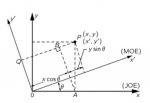I'm reading "6 not-so-easy pieces" by Feynman.
In an early chapter, they're discussing symmetry and rotation. And they present the following image.

Everything here seems to make sense. I understand most of this, but I have no idea where they got the YsinΘ from.
Maybe I'm overlooking some basic geometric property. But I just don't get it. Or maybe I'm just not good at visualizing problems.
In an early chapter, they're discussing symmetry and rotation. And they present the following image.

Everything here seems to make sense. I understand most of this, but I have no idea where they got the YsinΘ from.
Maybe I'm overlooking some basic geometric property. But I just don't get it. Or maybe I'm just not good at visualizing problems.
Last edited:
